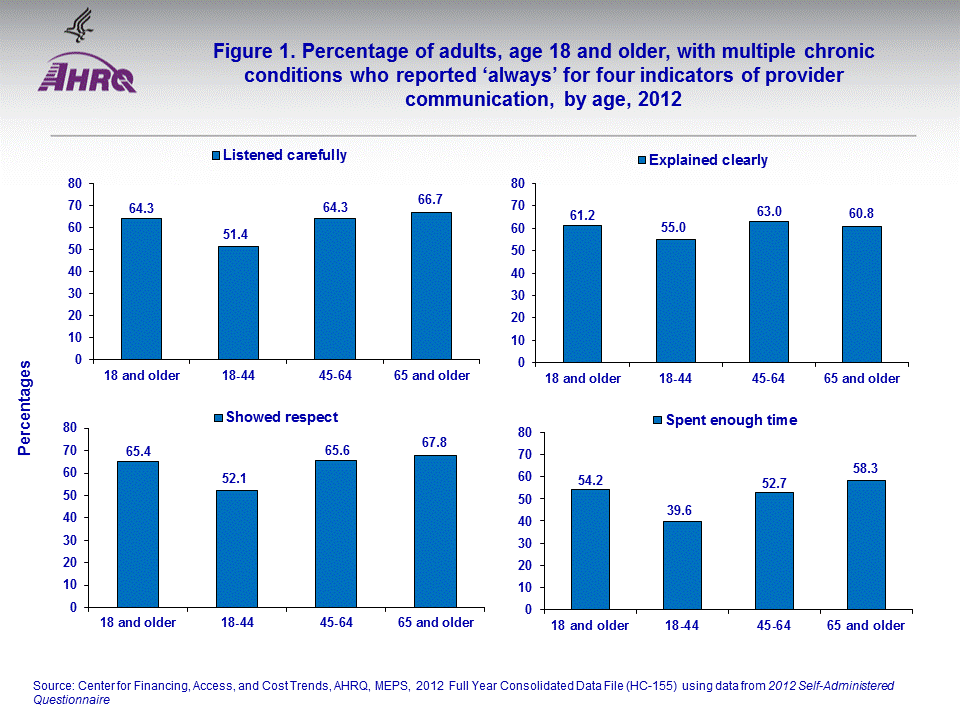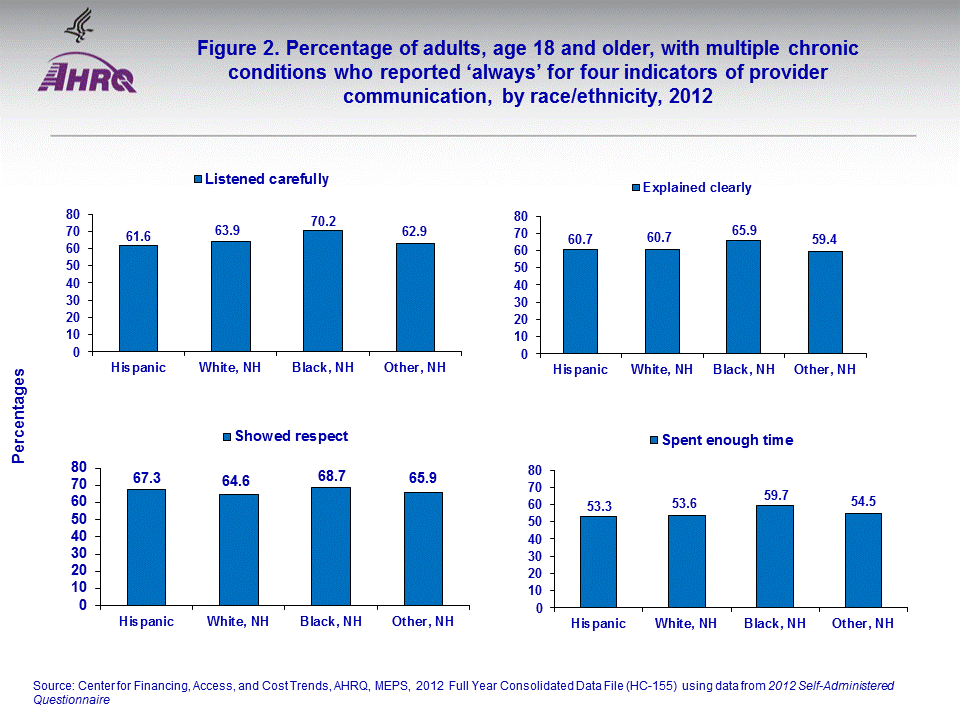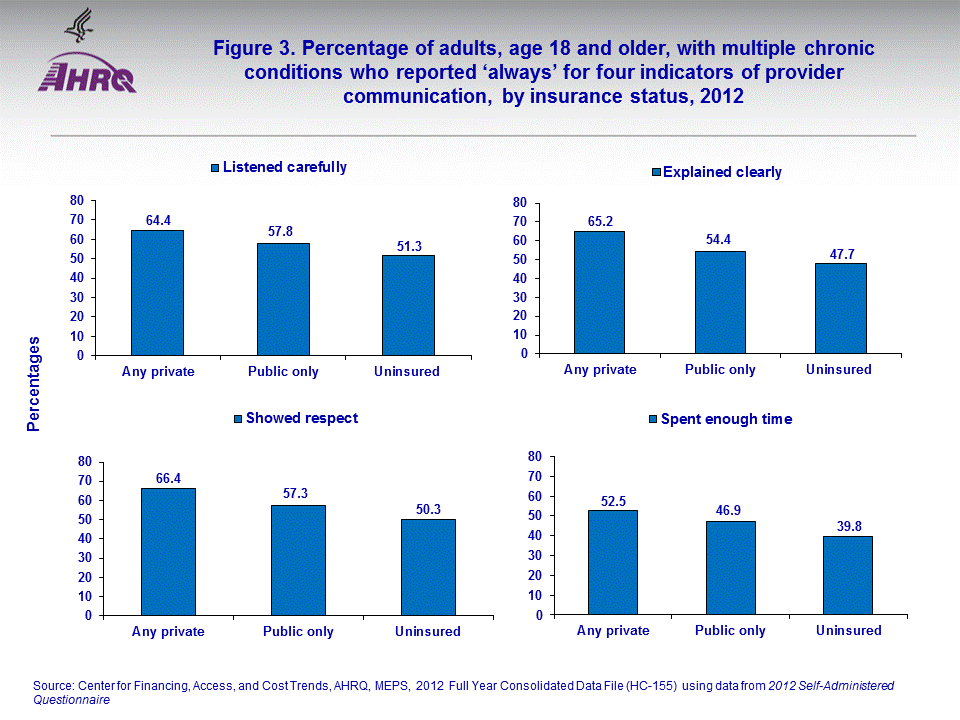
|
|
Font Size:
|
||||
|
|
|
|
||||
STATISTICAL BRIEF #483:
Experiences with Health Care Providers during Non-Emergency Care among Adults with Multiple Chronic Conditions, U.S. Civilian Noninstitutionalized Population, 2012
Highlights
- Almost two-thirds of adults with multiple chronic conditions reported that their providers always listened carefully to them during their non-emergency appointments. A similar proportion also felt their providers always showed respect for what they had to say.
- Slightly less than half of uninsured adults with multiple chronic conditions reported that their providers always explained things to them in a way that it was easy to understand.
- Adults with multiple chronic conditions who were poor were less likely to report that their providers always showed respect for what they had to say than adults with MCCs in all other income groups.
Introduction
Studies show that effective communication between providers and patients relates to better satisfaction and outcomes. Persons with multiple chronic conditions are a large and growing segment of the U.S. population. For these patients, provision of care is complex and communication with providers is especially critical. Based on data from the 2012 MEPS-HC, this Statistical Brief presents estimates of perceived quality of health care provider communication during non-emergency appointments among adults who were treated for multiple chronic conditions.In this Brief, a standard classification scheme for multiple chronic conditions is used that was developed by a working group of the Office of the Assistant Secretary for Health (OASH) in the Department of Health and Human Services (HHS). This classification scheme is consistent with the HHS strategic framework on Multiple Chronic Conditions (MCC)1,2. Using MEPS, a person was considered to have multiple chronic conditions if they had two or more treated conditions during the year from the OASH list of 20 conditions.
The estimates of provider communication are based on four items in the MEPS-HC Self-Administered Questionnaire which ask respondents about their providers' listening skills, clarity of explanations, respectfulness, and willingness to spend sufficient time with them (see "Definitions" for detailed questions). The estimates shown illustrate variation in quality of provider communication by age, insurance, poverty status, and race/ethnicity. All comparisons discussed in the text are statistically significant at the .05 level unless otherwise noted.
Findings
Nearly two-thirds of adults age 18 and over with MCCs felt that their providers always listened carefully to them during their non-emergency appointments (64.3 percent) and a similar proportion (65.4 percent) felt their providers showed respect for what they had to say (figure 1). A slightly smaller proportion of adults with MCCs felt their providers explained things clearly (61.2 percent) while just over half (54.2 percent) felt their providers spent enough time with them. As described below, there were notable variations in these four provider communication measures by age, race/ethnicity, insurance status, and poverty status of respondent.Age
Reporting of positive communication generally increased with age. Younger adults were less likely to report that their providers always listened to them carefully compared with the elderly (51.4 percent versus 66.7 percent) (figure 1). This was consistent for other measures of communication from providers. A lower percentage of younger adults reported that their providers explained things in a way that was easy to understand compared with adults ages 45-64 (55.0 percent versus 63.0 percent).
About 40 percent (39.6) of younger adults reported that their doctors always spent enough time with them compared to almost 60 percent (58.3) of those who were age 65 and older.
Race/ethnicity
In general, higher proportions of non-Hispanic blacks reported positively on the indicators of provider communication. For example, non-Hispanic black adults reported at higher rates than non-Hispanic white and Hispanic adults that their health care providers always listened carefully to them (70.2 percent versus 63.9 percent and 61.6 percent, respectively) (figure 2). In addition, nearly two-thirds of non-Hispanic black adults with multiple chronic conditions reported that their doctors always explained things to them in a way that was easy to understand as compared to Hispanic or non-Hispanic white adults with multiple chronic conditions (60.7 percent each).
Non-Hispanic black adults reported at a slightly higher rate than non-Hispanic white adults that the providers always showed respect for what they had to say (68.7 percent versus 64.6 percent) and 59.7 percent reported that their providers always spent enough time with them. This was higher than the rates for non-Hispanic white (53.6 percent) or Hispanic (53.3 percent) adults.
Insurance
Among adults ages 18-64, those with private insurance were most satisfied and the uninsured were least satisfied with provider communication (figure 3). Just over half (51.3 percent) of those who were uninsured reported that their providers always listened carefully to them. This was lower than those with public only insurance (57.8 percent) and those who had any private insurance (64.4 percent).
Almost two-thirds (65.2 percent) of nonelderly adults with any private insurance who had multiple chronic conditions reported that their providers always explained things in a way that was easy to understand. In comparison, adults with only public insurance and those who were uninsured reported at lower rates that their providers always listened to them carefully (54.4 percent and 47.7 percent, respectively).
Half of uninsured adults with multiple chronic conditions reported that their providers showed respect for what they had to say during their non-emergency appointments. This was lower than those with public only or any private insurance (57.3 percent and 66.4 percent, respectively).
While only about half (52.5 percent) of adults ages 18-64 with multiple chronic conditions and private insurance coverage reported that their providers spent enough time with them during their appointments, this percentage was higher than for adults with only public insurance and the uninsured (46.9 percent and 39.8 percent, respectively).
Poverty status
The quality of communication with providers tended to increase with income (figure 4).
For example, about two-thirds of adults in middle and high income families reported that their providers always listened carefully to them compared to only 58.9 percent of the poor.
Poor adults with multiple chronic conditions reported at lower rates than persons in middle or high income families that their providers always explained things in a way that was easy to understand (55.7 percent versus 62.9 percent and 63.8 percent, respectively).
Those who were poor also reported at lower rates than all other income categories that their providers always showed respect for what they had to say (58.4 percent versus 63.4 percent, 66.4 percent, and 68.7 percent).
About half of poor adults with multiple chronic conditions reported that their providers always spent enough time with them. This was lower than middle or high income adults (54.5 percent and 55.8 percent, respectively).
Data Source
The estimates shown in this Statistical Brief are based on data from the MEPS 2012 Full Year Consolidated Data File (HC-155), using data from the 2012 Self-Administered Questionnaire (SAQ). The SAQ asked respondents questions about their assessment of health care providers and systems. The health care quality measures in the SAQ were taken from the health plan version of Consumer Assessment of Healthcare Providers and Systems (CAHPS®), an AHRQ-sponsored family of survey instruments designed to measure quality of care from the consumer's perspective. All of the variables refer to events experienced in the last 12 months and were asked of adults age 18 and older.Definitions
The health care quality measures in the SAQ were taken from the health plan version of CAHPS®, an AHRQ-sponsored family of survey instruments designed to measure quality of care from the consumer's perspective.All of the variables refer to events experienced in the last 12 months and were asked of adults age 18 and older. In this Statistical Brief, the variables included from the CAHPS® are about communication with providers during non-emergency appointments; how often health providers listened carefully to them; how often health providers explained things in a way that was easy to understand; how often providers showed respect for what they had to say; and how often did health providers spend enough time with them.
SAQ weights were used to create the weighted estimates.
Only adults who reported at least one non-emergency appointment during the last 12 months were included in this analysis.
Poverty status
Four income groups were defined based on the percentage of the poverty line for total family income, adjusted for family size and composition. The following categories were used:
- Poor: Persons in families with incomes less than or equal to the poverty line, including those who reported negative income; and persons in families with incomes over the poverty line through 125 percent of the poverty line.
- Low income: Persons in families with incomes over 125 percent through 200 percent of the poverty line.
- Middle income: Persons in families with incomes over 200 percent through 400 percent of the poverty line.
- High income: Persons in families with incomes over 400 percent of the poverty line.
Individuals under age 65 were classified in the following three insurance categories based on household responses to health insurance status questions:
- Any private health insurance: Individuals, who, at any time during the year, had private insurance that provided coverage for hospital and physician care, were classified as having private insurance. Coverage by TRICARE (Armed Forces related coverage) was also included as private health insurance. Insurance that provided coverage for a single service only, such as dental or vision coverage, was not included.
- Public coverage only: Individuals were considered to have public coverage only if they met both of the following criteria: 1) they were not covered by private insurance at any time during the year, and 2) they were covered by one of the following public programs at any point during the year: Medicare, Medicaid, or other public hospital/physician coverage.
- Uninsured: The uninsured were defined as those not covered by private hospital/physician insurance, Medicare, TRICARE, Medicaid, or other public hospital/physician programs at any time during the year.
- Medicare only: Individuals who were covered by Medicare only during the year. For analytic purposes, this classification also included a very small number of persons age 65 and over who did not report Medicare coverage.
- Medicare plus private (including TRICARE): Individuals who at any time during the year, were covered by a combination of Medicare and TRICARE or private insurance.
- Medicare plus other public coverage: Individuals who, at any time during the year, were covered by Medicare and some other type of public insurance.
About MEPS-HC
MEPS-HC is a nationally representative longitudinal survey that collects detailed information on health care utilization and expenditures, health insurance, and health status, as well as a wide variety of social, demographic, and economic characteristics for the U.S. civilian noninstitutionalized population. It is cosponsored by the Agency for Healthcare Research and Quality and the National Center for Health Statistics.References
For a detailed description of the MEPS-HC survey design, sample design, and methods used to minimize sources of non-sampling errors, see the following publications:Cohen, J. Design and Methods of the Medical Expenditure Panel Survey Household Component. MEPS Methodology Report No. 1. AHCPR Pub. No. 97-0026. Rockville, MD. Agency for Health Care Policy and Research, 1997. http://meps.ahrq.gov/mepsweb/data_files/publications/mr1/mr1.shtml
Cohen, S. Sample Design of the 1996 Medical Expenditure Panel Survey Household Component. MEPS Methodology Report No. 2. AHCPR Pub. No. 97-0027. Rockville, MD. Agency for Health Care Policy and Research, 1997. http://meps.ahrq.gov/mepsweb/data_files/publications/mr2/mr2.shtml
Cohen, S. Design Strategies and Innovations in the Medical Expenditure Panel Survey. Medical Care, July 2003: 41(7) Supplement: III-5–III-12.
For more information about specialists and care for people with chronic conditions, see the following publications:
Preventing Chronic Disease Public Health Research, Practice and Policy. PCD Collection: Multiple Chronic Conditions 2013; 10: April 2013. DOI: http://www.cdc.gov/pcd/collections/pdf/PCD_MCC_Collection_5-17-13.pdf.
Goodman R.A., Posner S.F., Huang E.S., Parekh A.K., Koh H.K. Defining and Measuring Chronic Conditions: Imperitives for Research, Policy, Program and Practice. Preventing Chronic Disease 2013; 10: 120239. DOI: http://dx.doi.org/10.5888/pcd10.120239.
CAHPS®: https://cahps.ahrq.gov/cahps-database/about/index.html
Respecting patients is associated with more patient-centered communication behaviors in clinical encounters. Patient Education and Counseling 2015; Aug 20. pii: S0738-3991(15)30057-4. doi: 10.1016/j.pec.2015.08.020 http://www.ncbi.nlm.nih.gov/pubmed/26320821
Suggested Citation
Soni, A. Experiences with Health Care Providers during Non-Emergency Care among Adults with Multiple Chronic Conditions, U.S. Civilian Noninstitutionalized Population 2012. Statistical Brief #483. November 2015. Agency for Healthcare Research and Quality, Rockville, MD. http://www.meps.ahrq.gov/mepsweb/data_files/publications/st483/stat483.shtmlAHRQ welcomes questions and comments from readers of this publication who are interested in obtaining more information about access, cost, use, financing, and quality of health care in the United States. We also invite you to tell us how you are using this Statistical Brief and other MEPS data and tools and to share suggestions on how MEPS products might be enhanced to further meet your needs. Please email us at MEPSProjectDirector@hhs.ahrq.gov or send a letter to the address below:
Joel W. Cohen, PhD, Director
Center for Financing, Access, and Cost Trends
Agency for Healthcare Research and Quality
5600 Fishers Lane
Rockville, MD 20857
1 Preventing Chronic Disease – Public Health Research, Practice, and Policy. PCD Collection: Multiple Chronic Conditions 2013; 10: April 2013. DOI: http://www.cdc.gov/pcd/collections/pdf/PCD_MCC_Collection_5-17-13.pdf.
2 Goodman R.A., Posner S.F., Huang E.S., Parekh A.K., Koh H.K. Defining and Measuring Chronic Conditions: Imperatives for Research, Policy, Program and Practice. Preventing Chronic Disease 2013; 10: 120239. DOI: http://dx.doi.org/10.5888/pcd10.120239.
 |
||||||||||||||||||||||||||||||
|
||||||||||||||||||||||||||||||
|
|
||||||||||||||||||||||||||||||
 |
||||||||||||||||||||||||||||||
|
||||||||||||||||||||||||||||||
|
|
||||||||||||||||||||||||||||||
 |
||||||||||||||||||||||||||||||
|
||||||||||||||||||||||||||||||
|
|
||||||||||||||||||||||||||||||
 |
||||||||||||||||||||||||||||||
|
||||||||||||||||||||||||||||||
|
|
||||||||||||||||||||||||||||||


